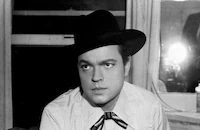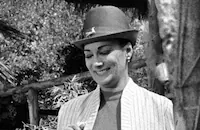Othello

Brief Synopsis
Cast & Crew
Orson Welles
Orson Welles
Michael Macliammoir
Suzanne Cloutier
Nicholas Bruce
Michael Lawrence
Film Details
Technical Specs
Synopsis
Durante il periodo delle Repubbliche Marinare, in Italia, Otello, detto "il moro di Venezia", viene inviato dal doge a difendere la roccaforte di Cipro dai musulmani, dopo il suo matrimonio con la bella e nobile Desdemona. Avendo scelto Cassio come aiutante, Otello provoca invidia e gelosia nel perfido Jago, che comincia ad insinuare dubbi sulla fedeltà della moglie. Con un artificio, il subdolo Jago crea "l'incidente del fazzoletto di Desdemona". A questo punto l'ingenuo Otello gli crede e, folle di gelosia, soffoca la moglie con un cuscino. Ma la verità viene a galla e Jago è smascherato e condannato a morte. Otello non resiste al rimorso e si suicida. Tratto dal dramma di Shakespeare, il film si rifà alla versione operistica di Arrigo Boito.
Director

Orson Welles
Cast

Orson Welles
Michael Macliammoir
Suzanne Cloutier
Nicholas Bruce
Michael Lawrence
Hilton Edwards

Fay Compton
Jean Davis

Robert Coote

Doris Dowling

Joseph Cotten

Joan Fontaine
Crew
Murray Allen
Daniel Aukin
Robert Baltrus
Alberto Barberis
Walter Bedone
Bob Bennett
Bruce Bernstein
Thomas Bieke
Bob Bosack
Lukas Bower
Lukas Bower
Robert Bowker
Anchise Brizzi
Richard Bykowski
Mark Caras
Mark Caras
Don Cox
Douglas Cunningham
Patrice Dali
Michael Dawson
Michael Dawson
Lorita De La Cerna
Maria De Matteis
Julien Derode
George Eastman
Rocco Facchini
George Fanto
Willy Ferrero
John Fogelson
John Fogelson
Casey Golbioski
Ed Golya
Ed Golya
Bill Gubbins
Mike Holloway
Alex Irvine
David Kalish
Francesco Lavagnino
John Leahy
Brett Leibsker
Scott Levitin
Dave Lewis
Donald Liebsker
Larry Logman
Renzo Lucidi
Rachel V Lyon
Rachel V Lyon
Matthew Mailman
Mikey Mcdonough
William Morton
Layni K Myers
Giorgio Patti
Michael Pendowski
Michael Pendowski
Greg Peters
Frederick E Roth
Jean Sacha
Arnie Saks
Terry Schilling
Barbara Schueren
William Shakespeare
John Shepridge
Dave Simpson
Peter Spataro
Edward Stone
James Trainor
Alexander Trauner
Jeffrey Turner
Joseph Weigel
Orson Welles
Orson Welles
Orson Welles
Steve Wilke
Leon Xintaris
Ray Yeo
Photo Collections
Videos
Movie Clip




Film Details
Technical Specs
Articles
Othello (1952)
Before he was even finished editing Macbeth, Welles had left America for Europe, having received a job offer to direct a movie of Cyrano de Bergerac for producer Alexander Korda. When that project collapsed, Welles became a roving actor on the many productions that sprang up on the Continent in the years after World War II. His appearance in The Third Man (1949) would be his most famous, but the one that got Othello started was when he played the hypnotist Cagliostro in Black Magic (1949). The movie was shot in Rome at Scalera Film Studios and, with his usual charm, Welles managed to talk the studio's owner, Mr. Scalera, into backing a quicky production of Othello to be shot in Morocco.
With Black Magic finished, Welles gathered a cast, crew and a detailed screenplay and brought them all to the town of Mogador on the coast of Morocco. And there they waited for the costumes to arrive. As Welles later recounted, "..we got a telegram saying the costumes wouldn't come because they hadn't been completed. A day later, a telegram came saying they hadn't been started. And then a telegram came saying that Scalera had gone bankrupt. So I had a company of fifty people in North Africa and no money."
Usually everyone would have just gone home. Instead Welles emptied out his own bank account and started rolling, improvising costumes and sets. When he finally ran out of funds, he dismissed the cast and crew and took roles in other movies to raise money, then reunited the cast and crew to shoot more footage until the money ran out again. "Three different times I had to close it and go away and earn money and come back, which meant you'd see me looking off-camera left, and when you'd cut over my shoulder, it would be another continent - a year later."
This process went on until the summer of 1951, three years after he'd begun filming. But the trouble was not over yet. The soundtrack was in rough shape and the lack of money for post-production led to a pieced-together soundtrack that was often indistinct. The movie shared the grand prize at the 1952 Cannes Film Festival, but in the United States the movie received mixed reviews, with many critics pointing out the poor audio quality.
Four years after Welles' death in 1985, his daughter Beatrice instigated a restoration project for her father's movie, a project made much easier when the negative and sound elements were discovered in a New Jersey warehouse. Once again four years were spent on Othello, this time just for the restoration. Computers were used to remove film blotches, dialogue was meticulously re-synced to the actors' lips and the musical score was re-recorded with modern sound equipment. The result was released in 1992 to great acclaim, hailed as one of the best adaptations of Shakespeare for the screen. It took forty-four years to do it, but Welles' movie that couldn't be made was finally complete with the power and beauty he had always intended.
Director: Orson Welles
Writers: William Shakespeare adapted by Orson Welles, Jean Sacha
Producer: Orson Welles
Cinematographers: Anchise Brizzi, G. R. Aldo, George Fanto, O. Troiani, R. Fusi
Editors: John Shepridge, Jean Sacha, Renzo Lucidi, William Morton
Music: Angelo Francesco Lavagnino, Alberto Barberis
Cast: Orson Welles (Othello), Michael MacLiammoir (Iago), Suzanne Cloutier (Desdemona), Robert Coote (Roderigo), Michael Laurence (Cassio), Fay Compton (Emilia).
BW-93m.
by Brian Cady

Othello (1952)
Quotes
Trivia
Orson Welles provides the voice for much of Roderigo's dialogue.
The movie was shot over three years and production was stopped twice, mainly because Wells ran out of money. He then starred in the films Third Man, The (1949) and _Prince of Foxes, The (1949)_ . He took his payment from those films and used them as money for "Othello"
Welles had another actress dub all dialogue of 'Suzanne Cloutier' .
Miscellaneous Notes
Released in United States Winter January 1, 1955
Re-released in United States March 6, 1992
Released in United States on Video January 13, 1993
Re-released in United States on Video November 2, 1994
Premiere in United States September 12, 1955
Released in United States 1992
Shown at San Francisco International Film Festival April 23 - May 7, 1992.
Micheal MacLiamoir replaced Everett Sloane in the role of Iago during production.
Lea Padovani and Betsy Blair were both considered for the role of Desdemona; Suzanne Cloutier replaced Cecile Aubry in the role during production.
Won best feature prize at 1952 Cannes Film Festival, where it was registered as a Moroccan production.
Began shooting Spring 1949.
Some sources have the shoot beginning in 1948.
Much of the dialogue was recorded wild (not synched to the picture).
Completed early 1952.
Released in United States Winter January 1, 1955
Re-released in United States March 6, 1992 (New York City)
Released in United States on Video January 13, 1993
Re-released in United States on Video November 2, 1994
Premiere in United States September 12, 1955 (premiere; New York City)
Released in United States 1992 (Shown at San Francisco International Film Festival April 23 - May 7, 1992.)













